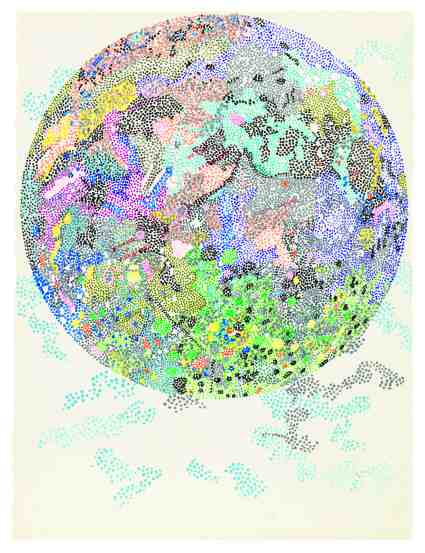
Nancy Graves’ art explores the connections between art, science, technology and geography. Her early 1970s conceptual paintings and drawings inspired by technological progressions in cartography, such as satellite imagery of the Earth, Moon and Mars, are currently on view at Mitchell-Innes & Nash‘s Chelsea location in New York City through April 6, 2019.
Graves’ compositions featured in the exhibition (titled Mapping), combine the aesthetic qualities of maps with scientific inquiry, in order to investigate both the artistic and informative nature of mapping. Her artistic process was akin to the way scientists research data, test theories and utilize technology and matter in revelatory ways. Through combining qualitative and quantitative information, Graves portrays maps as both formal abstractions and figurative representations of human explorations, insights and discoveries.
Graves’ map inspired work prompts us to think about the legibility of information, patterns in nature and our own personal bias regarding geography and technology. While science is an essential discipline for explaining the world, the arts humanize and intuit the essence of the world in ways that give gravity and symbolic meaning to scientific data.

One of the centerpieces in the exhibition is the mural-sized acrylic on canvas painting titled Mars (1973). The painting references NASA satellite imagery of Earth’s planetary neighbor, which was first being made public during the time that she was painting this 24 foot long composition. Graves’ painting reveals the topographic elements of Mars in a fragmented and abstract manner. This recalls the nature of how visual information is sometimes disseminated through arbitrary signals. The artist’s rendering of the satellite image, shows that data can be read both literally and figuratively.
Graves’ work is a perfect example of why STEAM (Science, Technology, Engineering, Art and Math) curricula is important within the educational sphere. With so much focus being put into learning science and technology, it is necessary at times to transcend literal authenticity and think symbolically in terms of our physical and metaphysical connection with the world. Art gives us a platform to incorporate subjectivity into objective knowledge. The inclusion of arts with other disciplines also enables us to develop and implement well rounded characteristics that can increase our ethical, social and emotional well-being. When artists make connections between art and science, they create novel ways of observing and expressing material and impressionistic views of the world. This ability to think and work within and beyond material and conceptual realms can result in a springboard for innovative and empathetic undertakings.
Full STEAM ahead!
